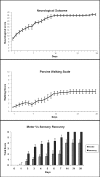Pediatric spinal cord injury in infant piglets: description of a new large animal model and review of the literature
- PMID: 20397443
- PMCID: PMC2853328
- DOI: 10.1080/10790268.2010.11689673
Pediatric spinal cord injury in infant piglets: description of a new large animal model and review of the literature
Abstract
Objective: To develop a new, clinically relevant large animal model of pediatric spinal cord injury (SCI) and compare the clinical and experimental features of pediatric SCI.
Methods: Infant piglets (3-5 weeks old) underwent contusive SCI by controlled cortical impactor at T7. Severe complete SCI was induced in 6 piglets, defined as SCI with no spontaneous return of sensorimotor function. Eight piglets received incomplete SCI, which was followed by partial recovery. Somatosensory evoked potentials, magnetic resonance imaging, neurobehavioral function, and histopathology were measured during a 28-day survival period.
Results: Mean SCI volume (defined as volume of necrotic tissue) was larger after complete compared with incomplete SCI (387 +/- 29 vs 77 +/- 38 mm3, respectively, P < 0.001). No functional recovery occurred after complete SCI. After incomplete SCI, piglets initially had an absence of lower extremity sensorimotor function, urinary and stool retention, and little to no rectal tone. Sensory responses recovered first (1-2 days after injury), followed by spontaneous voiding, lower extremity motor responses, regular bowel movements, and repetitive flexion-extension of the lower extremities when crawling. No piglet recovered spontaneous walking, although 4 of 8 animals with incomplete injuries were able to bear weight by 28 days. In vivo magnetic resonance imaging was performed safely, yielded high-resolution images of tissue injury, and correlated closely with injury volume seen on histopathology, which included intramedullary hemorrhage, cellular inflammation, necrosis, and apoptosis.
Conclusion: Piglets performed well as a reproducible model of traumatic pediatric SCI in a large animal with chronic survival and utilizing multiple outcome measures, including evoked potentials, magnetic resonance imaging, functional outcome scores, and histopathology.
Figures







References
-
- Vitale MG, Goss JM, Matsumoto H, Roye DP., Jr Epidemiology of pediatric spinal cord injury in the United States: years 1997 and 2000. J Pediatr Orthop. 2006;26(6):745–749. - PubMed
-
- Birney TJ, Hanley EN., Jr Traumatic cervical spine injuries in childhood and adolescence. Spine. 1989;14(12):1277–1282. - PubMed
-
- Dickman CA, Rekate HL, Sonntag VK, Zabramski JM. Pediatric spinal trauma: vertebral column and spinal cord injuries in children. Pediatr Neurosci. 1989;15(5):237–256. - PubMed
-
- Hadley MN, Zabramski JM, Browner CM, Rekate H, Sonntag VK. Pediatric spinal trauma: review of 122 cases of spinal cord and vertebral column injuries. J Neurosurg. 1988;68(1):18–24. - PubMed
-
- Ruge JR, Sinson GP, McLone DG, Cerullo LJ. Pediatric spinal injury: the very young. J Neurosurg. 1988;68(1):25–30. - PubMed
Publication types
MeSH terms
LinkOut - more resources
Full Text Sources
Medical
